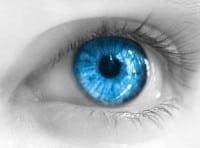
The notorious ‘Celebrity Stalker’ was apprehended last night after being spotted in a street crowd – with the help of cyborg eyes.
The latest improvements in bionic eyes, artificial eyeballs with light-sensitive chips and image enhancement software, have made myopia, sight defects, and even blindness a disability of the past. Marksmen and bodyguards have even opted for super-zoom lenses that virtually give them telescopic vision.
When Pete Edwards lost an eye in an accident last year, he thought his career as a VIP bodyguard was over. But his new bionic vision is actually an advantage in his work.
Programmed with facial recognition software, Pete was able to pick out the Stalker on a busy, darkened street.
Acting like tiny smart cameras that interface directly to the brain, bionic eyes give enhanced vision – even to those who were born almost entirely blind!
For a while, laser sculpting and cornea transplants displaced old-fashioned spectacles and contact lenses. Then biotech experts discovered a technique for cloning new eyes from healthy ones.
Advances in bio-synthesis – Synthetic DNA – allowed one to choose the color and efficiency of bio-engineered eyes.
Ultimately, nano-manufacture of organic chips and lenses has made artificial ‘cyborg’ eyes the best of the bunch. Even gene therapy for improved eyesight can’t compete with infra-red vision and photographic memory.
ANALYSIS >> SYNTHESIS: How this scenario came to be
“I’ll take 20/20 vision, in turquoise please”
That’s the future scenario for anyone troubled with genetic or age-related eye problems. Spectacles and contact lenses are so last-century. And as for laser surgery, that’s old hat. Now you just order the eyes you need, and have them fitted in a simple operation.
2004: Digital implants
Terry Byland from California is fitted with a 16-electrode implant after going blind with retinitis pigmentosa in 1993. “At the beginning, it was like seeing assembled dots – now it’s much more than that,” Terry says. “When I am walking along the street I can avoid low-hanging branches – I can see the edges of the branches.” The implant is connected to a tiny video camera and relays images to his retina.
2006: Gene therapy
In 2001, University of Florida and University of Pennsylvania researchers made a breakthrough. Using gene therapy, UF researcher William Hauswirth and his colleagues restored sight to dogs with the degenerative eye disease called Leber congenital amaurosis. Now the scientists are preparing to conduct a clinical trial of the treatment in people.
Researchers also are studying how to use bone marrow stem cells to repair retinal damage.
2007: Tissue engineering
In Singapore, Professor Leonard Kiang and his team are the first to transplant “autologous serum-free bioengineered ocular tissues” successfully for the treatment of a variety of eye diseases. They also develop ocular tissue-equivalents using new biosynthetic materials as “scaffolds for cell propagation in the area of ocular tissue-engineering”.
In simple terms, they are growing replacement eye tissues for implanting in defective eyes.
Trials begin with the Argus II system, which uses a spectacle-mounted camera to feed visual information to electrodes in the eye.
More than 2 million Americans opt for laser eye surgery. That’s a market of more than 11 billion US$ in the United States alone.
2010: Hi-res implants
Digital retinal implants get high definition as 512-pixel chips are implanted for the first time. In addition, the ‘camera’ is miniaturized sufficiently to be implanted in the eye itself, rather than worn on spectacles.
2012: Growing teeth and skin
Stem cell and cloning research has progressed to the point where certain replacement organs can be grown to order, using the patient’s own cells, rather than being transplanted from a donor. Replacement teeth and natural skin, which can be ‘printed’ from living tissue, are among the first ‘spare parts’ to be synthesized.
2015: Eye synthesis
Corneas, lenses and retinas become part of the ‘replacement part’ catalogue. Bio-engineering and bio-synthesis means that tissue can be ‘programmed’ from scratch – synthetic DNA.
2017: Bionic eyes
Using ‘organic’ nano-manufacture, integrating digital chips with living tissue, researchers are able to build an entire eyeball that functions like a digital camera, complete with zoom and memory. With infra-red capability, one can even see in the dark!
Warning: Hazardous thinking at work
Despite appearances to the contrary, Futureworld cannot and does not predict the future. Our Mindbullets scenarios are fictitious and designed purely to explore possible futures, challenge and stimulate strategic thinking. Use these at your own risk. Any reference to actual people, entities or events is entirely allegorical. Copyright Futureworld International Limited. Reproduction or distribution permitted only with recognition of Copyright and the inclusion of this disclaimer.
